Advertisements
Chapters
2: Ear to Ear
3: A Day with Nandu
4: The Story of Amrita
5: Anita and the Honeybees
6: Omana’s Journey
7: From the Window
8: Reaching Grandmother’s House
9: Changing Families
10: Hu Tu Tu, Hu Tu Tu
11: The Valley of Flowers
12: Changing Times
13: A River’s Tale
14: Basva’s Farm
15: From Market to Home
16: A Busy Month
17: Nandita in Mumbai
18: Too Much Water, Too Little Water
19: Abdul in the Garden
20: Eating Together
21: Food and Fun
22: The World in my Home
23: Pochampalli
24: Home and Abroad
25: Spicy Riddles
26: Defence Officer : Wahida
27: Chuskit Goes to School
![NCERT solutions for Environmental Studies - Looking Around [English] Class 4 chapter 1 - Going to School NCERT solutions for Environmental Studies - Looking Around [English] Class 4 chapter 1 - Going to School - Shaalaa.com](/images/environmental-studies-looking-around-english-class-4_6:ee4192f105d64896a9aea389b002fc4d.jpg)
Advertisements
Solutions for Chapter 1: Going to School
Below listed, you can find solutions for Chapter 1 of CBSE NCERT for Environmental Studies - Looking Around [English] Class 4.
NCERT solutions for Environmental Studies - Looking Around [English] Class 4 1 Going to School Try these [Page 1]
Collect some bricks. Lay them on the ground in a line as shown in the picture. Try walking on them. Was it easy?

Make a small bridge by tying 4 or 5 bamboo poles together. Ask your teacher to help you. Now walk on your bridge.
- How did you feel?
- Did you fall down?

Do you think it would be easier to walk on this bridge barefoot or with shoes or slippers? Why?
NCERT solutions for Environmental Studies - Looking Around [English] Class 4 1 Going to School Let us do [Pages 2 - 9]
Observe pictures 1 and 2. In the pictures, children are pulling the buckets from the well.

- Can you tell the difference in both the pictures?
- Which would be easier – using the pulley or not using it to lift things?
Look around you – where all do you see the use of pulleys? List them.
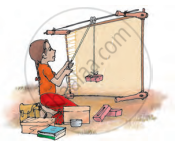
With the help of a pulley, try and lift various things, as shown in the picture.
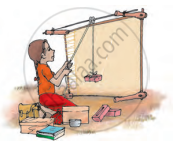

How is this bridge different from a bamboo bridge?
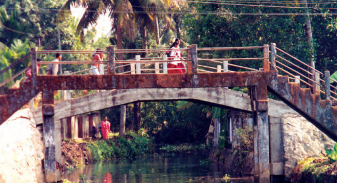
How many people do you think can cross the bridge at one time?

You have seen how children use a different kind of bridges, to cross rivers and other uneven areas to reach school.

If you had a chance, which bridge would you like to use? Why?

Do you have to cross any bridge on the way to your school? If yes, what is the bridge like? Draw its picture.

Find out from your grandparents, what kinds of bridges were there when they were young.
Is there any bridge near your house? Find out more about the bridge.
- Where is the bridge – over water, over a road, between two mountains or somewhere else?
- Who all use the bridge? Is it used by people on foot and also by vehicles and animals?
- Does the bridge seem to be old or is it new?
- Find out what materials are used in making this bridge. List some of them.
Draw a picture of the bridge in your notebook. Do not forget to draw the train, vehicles, animals or people who cross the bridge.
Imagine what difficulties there would be if the bridge was not there? Let us find out some other ways by which children get to school.
Have you seen any other kind of boats?
Can you think of other ways by which we can travel on water?
Have you ever sat in a camel-cart or horse carriage (tonga)? Where? Did you climb on it yourself, or did someone help you?
How did you feel riding in the cart? Also, share your experience in the class also.
Do you have bullock-carts where you live?
Does bullock-carts have a roof?
What kind of wheels do bullock-carts have?
Make a drawing of the cart in your notebook.
Can you ride a bicycle? If yes, who taught you to ride?
How many children come on bicycles to your school?
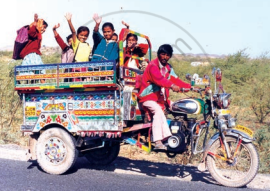
Do you have such vehicles in your area?

What do you call them in your area?

Would you like to ride in something like this? Why?

Can you tell why it is called jugad?

The jugad has been made by using waste material. Why don’t you also try to make something by putting together some waste material?
Have you ever been in a thick jungle or any such place?
Have you ever been in a thick jungle? Write your experiences in your notebook.
Can you recognise some birds by their sounds? Can you imitate the sounds of some birds? Do it.
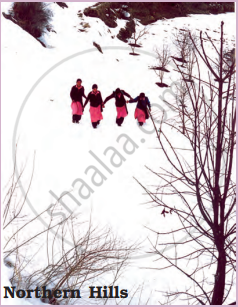
Have you ever seen so much snow? Where? In films or somewhere else?

Do you think that such places have snow all the time? Why?
Do you face difficulties on the way to your school?
Which is the best month, in which you like to go to school? Why?
See Me Walk!
Go to a ground or an open space with your friends. Act the way you will walk in these situations.
- The ground is made of soft and smooth rose petals.
- The ground is covered with thorns and there is tall grass on the sides.
- The ground is covered with snow.
Was there a difference in the way you walked each time? Discuss.
NCERT solutions for Environmental Studies - Looking Around [English] Class 4 1 Going to School Talk and share about it [Page 10]
Do you also have punishment in your school? What kind?
Do you think that punishment should not be there in schools?
If you come across any such incident, whom will you inform?
How will you make a complaint?
Is punishment the only solution to misdeeds? Make some rules for school to prevent misdeeds.
Draw a picture of your ‘dream school’ in your notebook and write about it and share in the class.
Solutions for 1: Going to School
![NCERT solutions for Environmental Studies - Looking Around [English] Class 4 chapter 1 - Going to School NCERT solutions for Environmental Studies - Looking Around [English] Class 4 chapter 1 - Going to School - Shaalaa.com](/images/environmental-studies-looking-around-english-class-4_6:ee4192f105d64896a9aea389b002fc4d.jpg)
NCERT solutions for Environmental Studies - Looking Around [English] Class 4 chapter 1 - Going to School
Shaalaa.com has the CBSE Mathematics Environmental Studies - Looking Around [English] Class 4 CBSE solutions in a manner that help students grasp basic concepts better and faster. The detailed, step-by-step solutions will help you understand the concepts better and clarify any confusion. NCERT solutions for Mathematics Environmental Studies - Looking Around [English] Class 4 CBSE 1 (Going to School) include all questions with answers and detailed explanations. This will clear students' doubts about questions and improve their application skills while preparing for board exams.
Further, we at Shaalaa.com provide such solutions so students can prepare for written exams. NCERT textbook solutions can be a core help for self-study and provide excellent self-help guidance for students.
Concepts covered in Environmental Studies - Looking Around [English] Class 4 chapter 1 Going to School are Going to School.
Using NCERT Environmental Studies - Looking Around [English] Class 4 solutions Going to School exercise by students is an easy way to prepare for the exams, as they involve solutions arranged chapter-wise and also page-wise. The questions involved in NCERT Solutions are essential questions that can be asked in the final exam. Maximum CBSE Environmental Studies - Looking Around [English] Class 4 students prefer NCERT Textbook Solutions to score more in exams.
Get the free view of Chapter 1, Going to School Environmental Studies - Looking Around [English] Class 4 additional questions for Mathematics Environmental Studies - Looking Around [English] Class 4 CBSE, and you can use Shaalaa.com to keep it handy for your exam preparation.
